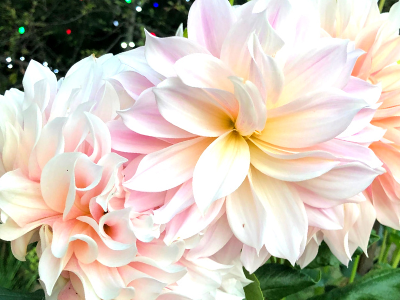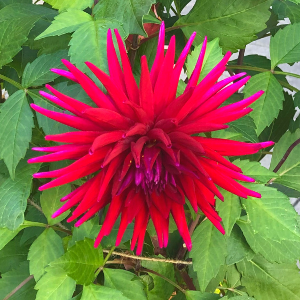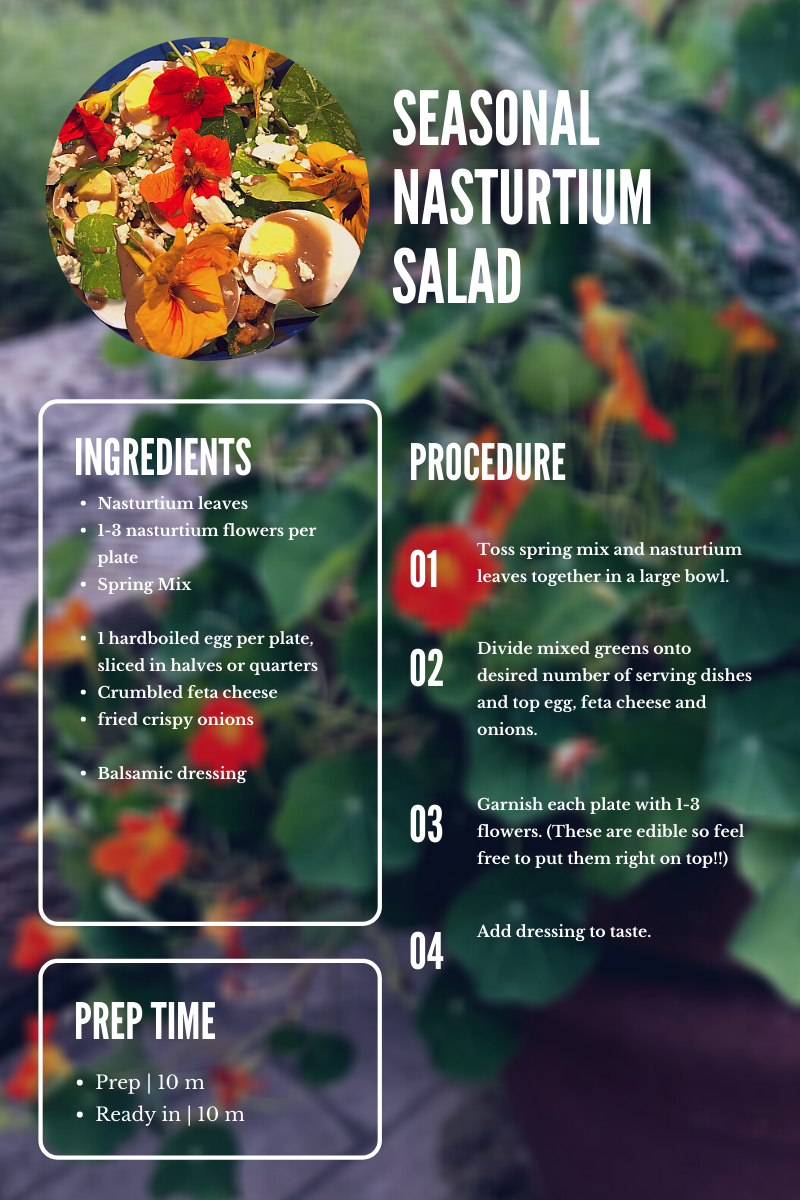I’ve decided to rechristen 2020 as the “Year of the Dahlia.” Maybe no one outside of the Zoo’s horticulture department feels this way, but in a year with so much uncertainty and craziness, something as simple as a pretty flower brought so much continuity and pleasure. Every time I walked into the Welcome Center, their bright, radial blooms greeted me in a range of happy colors.
 I had never grown a dahlia before 2020. I personally prefer plants that are less flashy and are more utilitarian — which is why I sometimes question my career in horticulture. I’ve spent time doing agricultural work in the Peace Corps and on urban farms cultivating edible plants. I’ve also worked at renowned horticultural institutions, like The Holden Arboretum and Philadelphia’s Longwood Gardens, and while absolutely spectacular in their horticultural magnificence, these institutions already know what they are — plant places that cater to plant people. The Zoo is much different.
I had never grown a dahlia before 2020. I personally prefer plants that are less flashy and are more utilitarian — which is why I sometimes question my career in horticulture. I’ve spent time doing agricultural work in the Peace Corps and on urban farms cultivating edible plants. I’ve also worked at renowned horticultural institutions, like The Holden Arboretum and Philadelphia’s Longwood Gardens, and while absolutely spectacular in their horticultural magnificence, these institutions already know what they are — plant places that cater to plant people. The Zoo is much different.
What I love about the Zoo is that it gives me the flexibility to fuse the utilitarian, agricultural world with the highly-aesthetic, horticultural world. The Zoo is an animal place that mainly caters to animal people. However, we also achieved our botanical garden certification a few years ago, and we hired a new horticultural manager, Kris Jackson, at the beginning of this year. The goal of our team is to convince our guests of the importance of plants when they visit. When we do this, we’ve accomplished something really special—and difficult.
This is what inspired me to plant dahlias in front of the Welcome Center. As every guest enters our park, I wanted them to see something new and flashy that would make them appreciate plants, even before they had a chance to appreciate the animals.
Dahlias originated in Mexico. The Aztecs who lived there favored one species of dahlia in particular— the red dahlia, which looks much more like a simple daisy than the giant, dinner-plate size dahlias that are so renowned today. The Aztecs weren’t growing these plants for the flower, however. Rather, they were growing it for the tuber. In fact, the Aztecs used the dahlia in the same way that we use the potato—as a nutritious starch crop.
Sometime after the conquistadors conquered Mexico, dahlias as a source of food went out of fashion. However, from this loss arose an appreciation for a new horticultural marvel. Botanists brought dahlias back to Spain, and hybridization practices over the years eventually culminated in the creation of the “double-flowered” dahlia, a genetic mutation where the flower has extra petals, making it look like a flower within a flower.
When considering what to plant at the Zoo, I wanted to emphasize ornamental plants that have edible qualities, or “edimentals.” So instead of going for the most modern, over the top dahlias, I opted for the slightly less hybridized plants that were popular in the 40s, 50s, and 60s, since these dahlias are better for eating. My plant budget was only $200, but I had hoped to show people that growing plants from seeds is both economical and satisfying.
 For months, I anticipated the day that I’d dig up my dahlia tubers. For months and months I watered them, I fertilized them, and I sprayed them with Liquid Fence to deter those ever-ravenous groundhogs. I gave them extra love, because I wanted to dig up many more tubers than I put into the ground—so that I could save most of them for next year’s floral display, and to retain a small percentage for eating purposes.
For months, I anticipated the day that I’d dig up my dahlia tubers. For months and months I watered them, I fertilized them, and I sprayed them with Liquid Fence to deter those ever-ravenous groundhogs. I gave them extra love, because I wanted to dig up many more tubers than I put into the ground—so that I could save most of them for next year’s floral display, and to retain a small percentage for eating purposes.
See, the thing is that dahlias are very high maintenance plants. In addition to the watering, fertilizing, and pest-deterrence, they need to be staked and tied up constantly, and their spent blooms need to be dead-headed to keep them flowering at maximum potential. The couple hours a week I put into engaging in these acts allowed me some time to reflect and meditate on how grateful and thankful I was for things. Something as simple as the dead-heading of dahlias became a ritual. I relied on this ritual to start each of my weeks with purpose and relaxation.
In constant conversations with the rest of the horticulture department, I’ve had a Thanksgiving nearly every month this year. I see people around the world struggling because of COVID, but here at the Zoo I’ve felt really safe, and I’ve been able to maintain continuity in my life. I’ve been thankful for my health, for my friends and coworkers, for my job, and for the fact that the Zoo saw benefit enough in horticulture to keep us all on staff throughout the pandemic. This gives me a lot of hope for the future.
As the growing season turns to winter, enthusiasm for outdoor plants wanes, and people start to lose interest in their green thumbs. But, my thumb stays green because I’m going through the new ritual of learning how to preserve dahlia tubers throughout the winter. To peoples’ chagrin, I cut down the still somewhat impressive looking plants after a couple frosts and dug up the tubers. I was thrilled to find many more than I’d put into the ground, and, after washing the soil off, I hung them up to start preparing them for winter storage. Another aspect of their high maintenance is that there are specialized ways of curing them and preserving them so that they last through the cold months. I read lots of articles about the best methods, and I’ll be experimenting with a few different ways, but I really won’t know until the spring if I’ve had any success. It makes me appreciate what the farmers of yore went through with preserving and canning their crops for the winter.
But, the most I can do is take things one step at a time. So, tonight, I’ll grate the dahlia tubers that I won’t be saving through the winter, mix them with eggs and flour, and fry them in butter. I’m told that this tastes similar to a potato pancake—just nuttier. Then I’ll top it off with salmon, sour cream and dill as part of a small feast. Pair that with a salad topped with Nasturtium leaves (another incredible edimental, which tastes very spicy, like a radish) and flowers and, despite being small, this meal will be a proper feast for my memory. A proper way to end 2020. To find beauty in the mess. To be thankful for the plants that bring continuity to our lives.


